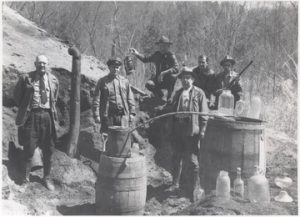Shown above is a photo from the 1950s of a raid by U.S. Treasury officials known as “revenuers” or “revenooers” on a moonshine whiskey distilling operation in Summers County. Making illegal moonshine has long been a cottage industry in this area of West Virginia. Settlers to the Appalachians from the British Isles brought with them whiskey making skills that they applied to making whiskey from field corn. The term moonshine comes from making and distributing the whiskey in the dark of the night. After Congress imposed taxes on moonshine in the late 1700s, illegal whiskey production continued in earnest through a period of state and national prohibition of alcohol sales that ended in 1933. All that was needed was corn, spring water, and wood or coal for fuel. To evade government tax agents and local enforcement officers, secluded locations were necessary. While the distilling apparatus called “stills” were generally located in heavily wooded areas, they were also set up in deserted coal mines, caves, and rooms dug out beneath barns.
Evidently, West Virginia moonshine achieved a certain amount of acclaim by moonshine devotees. Legend has it that the governor of North Carolina, while visiting The Old White (predecessor to The Greenbrier), told the governor of South Carolina that West Virginia whiskey had “one kick ahead of that produced in Kentucky, Tennessee and the Carolinas.” He said the liquor made the “rabbit spit in the bull-dog’s eye.” It was reported the moonshine he was drinking came from Kate’s Mountain.
Jumping forward several years, the descents of West Virginia and North Carolina moonshiners are carrying on their families’ enterprises. Dusta Tanner, whose family made moonshine in Roane County, has joined the Bullock family, whose ancestors made whiskey in North Carolina, to open The Bullock Distillery in Charleston, WV. This year their Straight Bourbon was awarded the Double Gold Designation at the San Francisco World Spirits Competition. It is a coveted distinction as only a few entries out of thousands achieve the Double Gold. Proofing water for Bullock’s bourbon comes from Bullock’s Cave in Greenbrier County.
Photo: Courtesy of the West Virginia University Regional History Center.
Sources: Charleston Gazette-Mail, Hinton Daily News, The History of Moonshine in West Virginia by Gary Wilcox.



